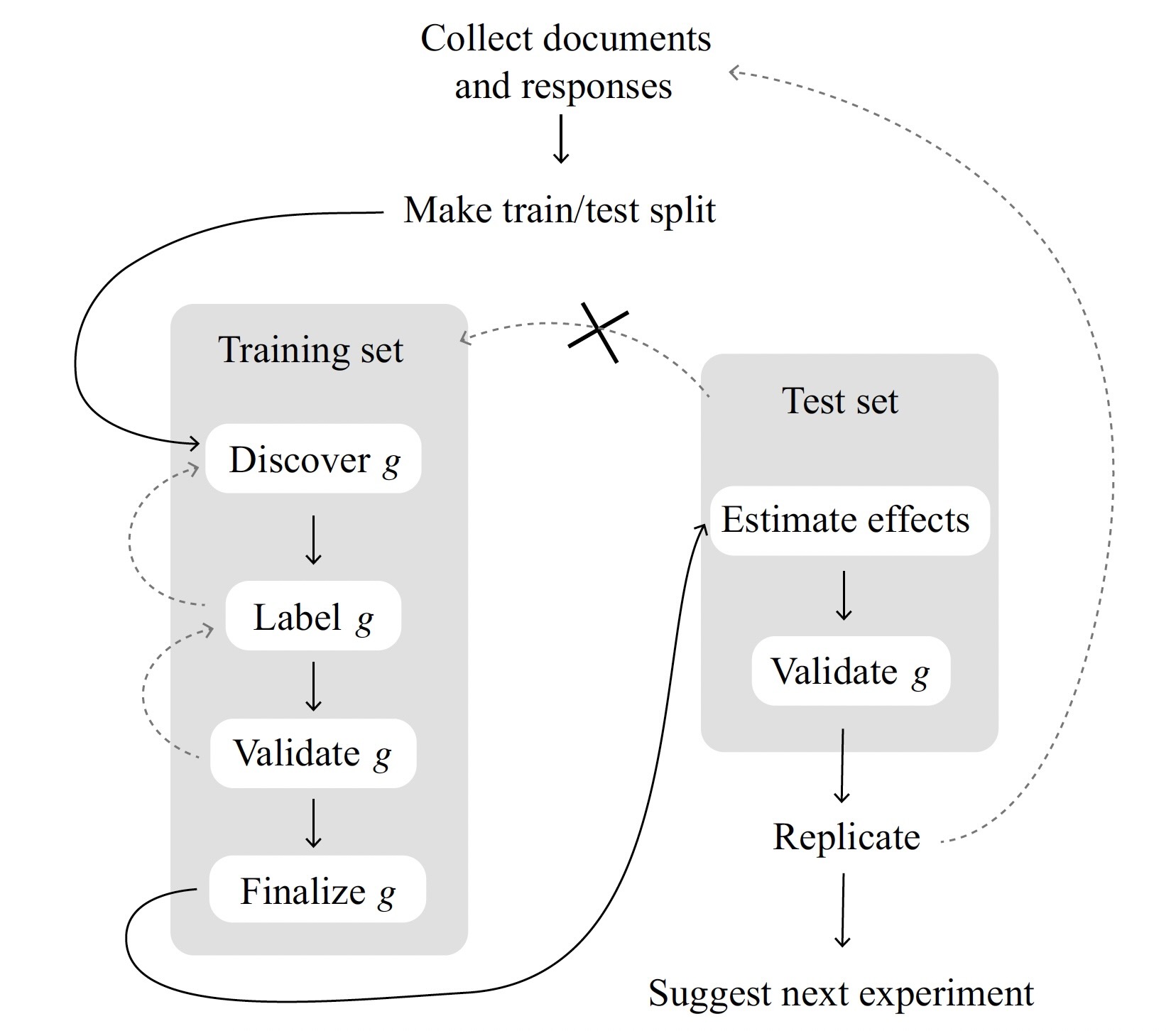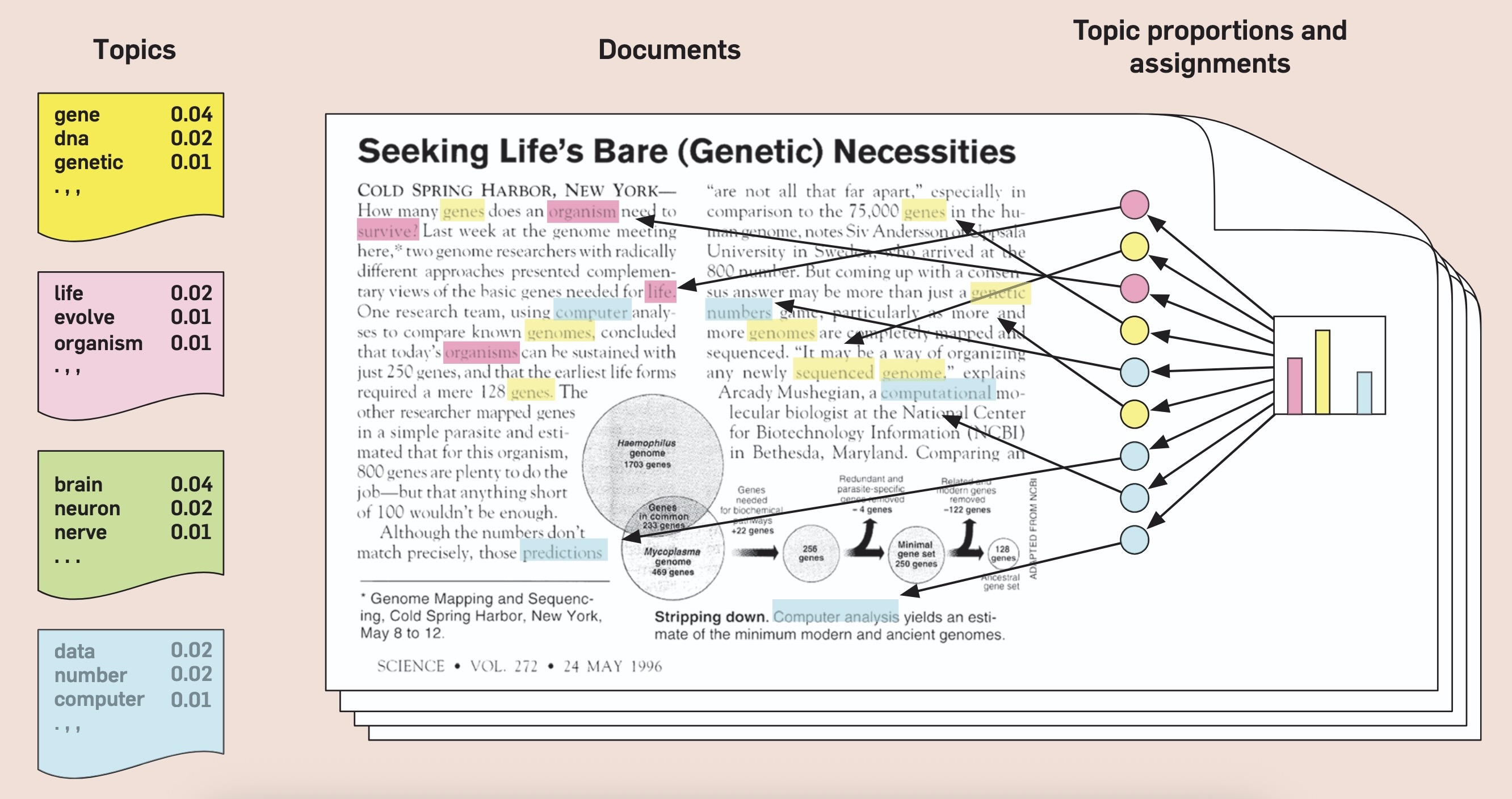Week 10: Text-as-Data
DSAN 5650: Causal Inference for Computational Social Science
Summer 2025, Georgetown University
Schedule
Today’s Planned Schedule:
| Start | End | Topic | |
|---|---|---|---|
| Lecture | 6:30pm | 6:45pm | Final Projects: Dependent vs. Independent Vars → |
| 6:45pm | 7:10pm | Instrumental Variables Lite → | |
| 7:10pm | 8:00pm | Text-as-Data Part 1: TAD in General → | |
| Break! | 8:00pm | 8:10pm | |
| 8:10pm | 9:00pm | Text-as-Data Part 2: Causal Text Analysis → |
\[ \DeclareMathOperator*{\argmax}{argmax} \DeclareMathOperator*{\argmin}{argmin} \newcommand{\bigexp}[1]{\exp\mkern-4mu\left[ #1 \right]} \newcommand{\bigexpect}[1]{\mathbb{E}\mkern-4mu \left[ #1 \right]} \newcommand{\definedas}{\overset{\small\text{def}}{=}} \newcommand{\definedalign}{\overset{\phantom{\text{defn}}}{=}} \newcommand{\eqeventual}{\overset{\text{eventually}}{=}} \newcommand{\Err}{\text{Err}} \newcommand{\expect}[1]{\mathbb{E}[#1]} \newcommand{\expectsq}[1]{\mathbb{E}^2[#1]} \newcommand{\fw}[1]{\texttt{#1}} \newcommand{\given}{\mid} \newcommand{\green}[1]{\color{green}{#1}} \newcommand{\heads}{\outcome{heads}} \newcommand{\iid}{\overset{\text{\small{iid}}}{\sim}} \newcommand{\lik}{\mathcal{L}} \newcommand{\loglik}{\ell} \DeclareMathOperator*{\maximize}{maximize} \DeclareMathOperator*{\minimize}{minimize} \newcommand{\mle}{\textsf{ML}} \newcommand{\nimplies}{\;\not\!\!\!\!\implies} \newcommand{\orange}[1]{\color{orange}{#1}} \newcommand{\outcome}[1]{\textsf{#1}} \newcommand{\param}[1]{{\color{purple} #1}} \newcommand{\pgsamplespace}{\{\green{1},\green{2},\green{3},\purp{4},\purp{5},\purp{6}\}} \newcommand{\pedge}[2]{\require{enclose}\enclose{circle}{~{#1}~} \rightarrow \; \enclose{circle}{\kern.01em {#2}~\kern.01em}} \newcommand{\pnode}[1]{\require{enclose}\enclose{circle}{\kern.1em {#1} \kern.1em}} \newcommand{\ponode}[1]{\require{enclose}\enclose{box}[background=lightgray]{{#1}}} \newcommand{\pnodesp}[1]{\require{enclose}\enclose{circle}{~{#1}~}} \newcommand{\purp}[1]{\color{purple}{#1}} \newcommand{\sign}{\text{Sign}} \newcommand{\spacecap}{\; \cap \;} \newcommand{\spacewedge}{\; \wedge \;} \newcommand{\tails}{\outcome{tails}} \newcommand{\Var}[1]{\text{Var}[#1]} \newcommand{\bigVar}[1]{\text{Var}\mkern-4mu \left[ #1 \right]} \]
Final Project Timeline
- Proposal (Abstract on Notion):
- Submitted to instructors by Tuesday, July 15th, 6:30pm EDT ✅
- Approved by an instructor by Tuesday, July 22nd, 6:30pm EDT ✅
- Final Draft:
- Submitted to instructors for review by Friday, August 1st, 5:59pm EDT
- Approved by an instructor by Monday, August 4th, 11:59pm EDT
- Final Submission:
- Submitted via Canvas by Friday, August 8th, 5:59pm EDT
Independent vs. Dependent Variables
- Starting point: puzzle in social world!
- Why are fertility rates dropping in these countries?
- What explains the move from “quietism” to “Political Islam”?
- What behaviors produce positive health outcomes in old age?
Independent Variable / Treatment \(D\)
- What happens when…
- [Someone gets a degree/internship]
- [There are casualties in a conflict]
- Start with independent var \(\Rightarrow\) “What are the effects of this cause?”
Dependent Variable / Outcome \(Y\)
- “I wonder what explains this?”
- [Differences in earnings]
- [Probability of news story]
- Start with dependent var \(\Rightarrow\) “What are the causes of this effect?”
Text-as-Data Part 1: TAD in General
- Computers don’t exactly “read” text! They process numeric representations of some feature(s) of the text
- Ex: sentiment, topic, embedding in semantic space
- \(\Rightarrow\) When we do causal inference with text, we’re not studying \(D \rightarrow Y\) itself! Instead, we study:
- Text as Outcome: \(D \rightarrow g(Y)\) and/or
- Text as Treatment: \(g(D) \rightarrow Y\)
Text-as-Data Part 2: Causal Inferences with Text
(The necessity for sample splitting!)
- Recall the media effects example from Week 3; here an experiment where:
- Treatment (\(D_i = 1\)) watches presidential debate (control doesn’t watch anything)
- Outcome \(Y_i\): We estimate a topic model of the respondent’s verbal answer to “what do you think are the most important issues in US politics today?”
| \(Y_i \mid \textsf{do}(D_i \leftarrow 1)\) | \(Y_i \mid \textsf{do}(D_i \leftarrow 0)\) | |
|---|---|---|
| Person 1 | Candidate’s Morals | Taxes |
| Person 2 | Candidate’s Morals | Taxes |
| Person 3 | Polarization | Immigration |
| Person 4 | Polarization | Immigration |
“Discovered” Topics Depend on the Data 😟
| \(Y_i \mid \textsf{do}(D_i \leftarrow 1)\) | \(Y_i \mid \textsf{do}(D_i \leftarrow 0)\) | |
|---|---|---|
| Person 1 | Candidate’s Morals | Taxes |
| Person 2 | Candidate’s Morals | Taxes |
| Person 3 | Polarization | Immigration |
| Person 4 | Polarization | Immigration |
| Actual Assignment | Outcome \(Y_i\) | |
|---|---|---|
| Person 1 | \(D_1 = 1\) | Morals |
| Person 2 | \(D_2 = 1\) | Morals |
| Person 3 | \(D_3 = 0\) | Immigration |
| Person 4 | \(D_4 = 0\) | Immigration |
| Actual Assignment | Outcome \(Y_i\) | |
|---|---|---|
| Person 1 | \(D_1 = 1\) | Morals |
| Person 2 | \(D_2 = 0\) | Taxes |
| Person 3 | \(D_3 = 1\) | Polarization |
| Person 4 | \(D_4 = 0\) | Immigration |
The Solution? Sample Splitting!
- Machine learning noticed this long ago: the goal is a model that generalizes, not memorizes!

Topic Models
- Intuition is just: let’s model latent topics “underlying” observed words
| Section | Keywords |
|---|---|
| U.S. News | state, court, federal, republican |
| World News | government, country, officials, minister |
| Arts | music, show, art, dance |
| Sports | game, league, team, coach |
| Real Estate | home, bedrooms, bathrooms, building |
- Already, by just classifying articles based on these keyword counts:
| Arts | Real Estate | Sports | U.S. News | World News | |
|---|---|---|---|---|---|
| Correct | 3020 | 690 | 4860 | 1330 | 1730 |
| Incorrect | 750 | 60 | 370 | 1100 | 590 |
| Accuracy | 0.801 | 0.920 | 0.929 | 0.547 | 0.746 |
Topic Models as PGMs

…Unlocks a world of social modeling through text!
Cross-Sectional Analysis
Blaydes, Grimmer, and McQueen (2018)
Influence Over Time
